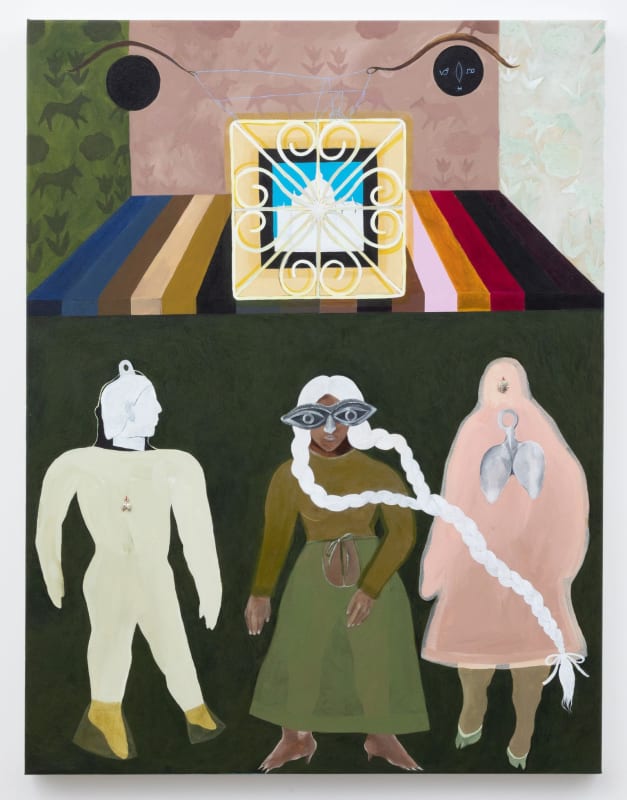When Baudelaire’s flâneur mourned the loss of medieval Paris to Baron Haussmann’s grands boulevards, it was not architecture he grieved but the city’s unsung anti-heroes, clinging to its shadowy alleyways—beggars, prostitutes, sanitary workers, and gamblers. In Baudelaire’s manifesto collection of poems Les Fleurs du mal, such figures stood for decadence, eroticism, and fantasy, those qualities that, although prohibited in polite society, seemed nevertheless to bubble up through its cracks. Masterworks like Baudelaire’s volume hold the power to distill the culture of their moment, but just as important are those occasions when such masterworks assume new urgency as a shorthand for the concerns they articulated in their own time. With Baudelaire’s compendium as their touchstone, gallerist and artist Karen Hesse Flatow and guest curator Nicole Kaack show that Baudelaire’s chief concerns remain productive terrain for an emerging generation of artists whose diverse work is gathered in The Symbolists: Les Fleurs du mal at Hesse Flatow.
In this exhibition, painting, sculpture, and video work by 15 artists and one collective call into question art’s capacity to represent things as
they are. Here, art is instead a vehicle for world-making of other kinds: for imagining the cooperative and conflictual ways different life forms, technologies, and forms of knowledge interact. In Hesse Flatow’s largest gallery, symbols of past and future mix to propose a present where human and non-human collide. With compositional clarity that recalls Mayan reliefs, Astrid Terrazas’s potent acrylic on canvas Retrato familiar (2020) animates symbols of ancestral folklore: in this work we encounter three hoof-footed humans adorned by painted and actual silver Milagros, standing out against an army-green ground. Above, a butter-yellow window suspended by a blue gossamer thread glows like a talisman while also offering a glimpse of a white shrine beyond.
Looking to the future rather than the past, sculptures by Louis Osmosis offer tools for survival in uncertain territory. His papier-mâché Engine (2020), with its toilet roll tube, Johnsian light bulb, and mirrored monocle-cum-periscope is both deadly serious and absurd. Osmosis’s sabre-wielding mannequin Default_01 (To Firmly Grasp It). (2021) leaks blue streaks through a black t-shirt like expressed breastmilk, suggesting, perhaps, a future of upended gender hierarchies. Painted against a tidy white ground, the satellite, sword, fighter jet, and pyramid of Exene Karros’s what happens when You die (2020) counterpose symbols of ancient dynastic stability with current aspirations for technological progress, yet its flow-chart structure ends (or begins?) with bright red question marks. Scientific inquiry, here and elsewhere in the show, returns only mystery.
In another gallery, Johanna Robinson insinuates the permeability of boundaries between reality and fiction, optical and visionary sight in Imagination is defined by what lies outside it (2020). Myth escapes captivity as an object of lust or empirical scrutiny in Robinson’s painting: the magical beast of the Met’s famed unicorn tapestry has escaped its fenced cage, leaving in its place nothing but an ethereal light source that blasts otherworldly rays across the raised fibers of the work’s cheesecloth ground. In Robinson’s Feast or Famine (2021), an exposed electrical cord rests on the floor of an aqueous, azure dreamscape beset with fireflies. The artist seems to suggest that reality is always constructed, a theme likewise treated in Maho Donowaki’s’s I’ll Swim if You Swim Too (2021), a fishbowl flowing with glycerin topped by a resin block imprinted with human feet.
And yet, all these myth-laden new worlds seem shot through with hope, however improbably. The smooth plateaus and dusky craters of Alicia Adamerovich’s surreal landscapes provide, more prosaically, a ground for the worlds the show reimagines, one where motherhood (as in Hilary Doyle’s melting subway scene The Innocents [2020], and masculinity (as in the tender Norseman of Nat Meade’s Cry Drops [2021]), might be reconfigured. The show’s video program presents women as especially fierce: Alicia Smith embodies the shape-shifting jaguar of Mesoamerican folk religion in Nagualism (2017), while a segment from Sistership TV restores the terrifying nature of mythological sirens, long since objectified in art. Indeed, the show’s capacious conceptual frame encourages the imaginative acts its works already recommend. It is a vital space of communion with art, if not with others, so welcome at the twilight of a year of enforced isolation. Perhaps that is the most effective argument one could make for the sustaining power of myth, dreams, and the expanded virtual worlds they shape, as the quotidian aspects of our terrestrial existence now feel especially ripe for creative reimagining.



